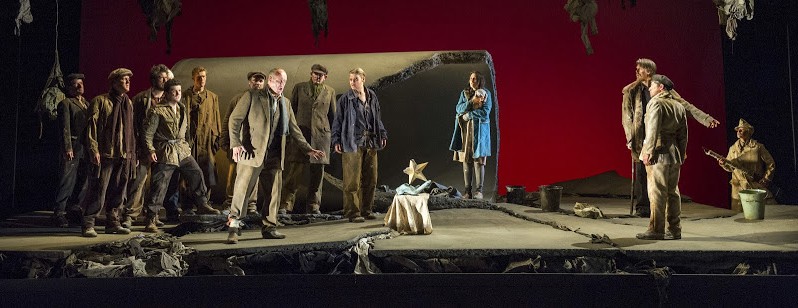The Siege of Calais: Review
Lizzy Leech reviews the newly rejuvenated English Touring Opera production of The Siege of Calais, Donizetti’s rarely performed epic about the burghers of Calais.
I decided to go to the ETO production of The Siege of Calais with no understanding of the plot, to avoid any preconceptions. A risky approach to opera perhaps, for an understanding of the story line could arguably have heightened the overall appreciation of music and performance. However, by the end of the production, I realised I need not have been worried; this production of The Siege of Calais lacked a very complex plot.
Initially, the pace took a while to get going but it became clear that the premise of the plot was that the characters were trapped in a static situation. This was partly due to the production’s decision to re-order the original three act opera and reduce it to a tragic and more concentrated two acts; the opera’s composer, Donizetti, was dissatisfied with the third act, and did plan to rewrite it. Edoardo’s Brillante aria in Act Three was repositioned to the beginning of Act One. Reorganised as such, the production not only ended without hope, but arguably without an ending itself. The final, moving scene, showed the men leaving, at last to leave and do what they had spent most of the opera discussing (it is presumed that the burghers are executed), leaving the audience to contemplate the ultimate, tragic fate of the men. The play ended with an overriding sense of dissatisfaction that there was no conclusion. In combination with a modern design which brought the Cold War to mind, the post-Holocaust setting and Stalingrad aesthetic, described by director James Conway as ‘the definitive siege of modern times’, the production conveyed a sense of complete futility.
Samal Blak’s design was striking. Clothes were piled high, spilling from the cracks of the barren concrete stage and hung above the set, which created a sense of unease, reminiscent of a concentration camp. The stage felt sinister and created an uneasy atmosphere, emphasised by Ace McCarron’s impressionistic lighting design. A large broken pipe, centre stage provided the focal point and a place for the characters to inhabit. The pipe rotated to show the two sides of the wall, which was an incredibly exciting part of the otherwise stationary set. However, rather than rotate between the first and second scene, the pipe remained static for the remainder of the production. I found myself anticipating the next rotation of the pipe, which disappointedly never happened. The plot was in stasis when the characters were entrapped in the siege. Consequently, I found the opera to be an exploration of how to present inaction through art.
The overwhelming futility of the plot line contrasted greatly to the lively score. Conducted by Jeremy Silver, Donizetti’s music was hardly tragic. I left humming the regal and jubilant arias. Although written in 1836, this production had an incredibly modern feel, both in its setting and staging, but also in the way the ETO restructured the opera itself. It had an element of post-war pessimism and pointlessness about it that I found reminiscent of the bleak and absurd situations of the works of Beckett. Donizetti’s opera may have faded into obscurity through the lack of an eventful storyline and its contradictions between genre and musical style, but I found, by questioning the operatic form and the presentation of man in a state of waiting and impending doom, it was an incredibly dramatic production.
The Siege of Calais, an English Touring Opera production, is touring until 21 May 2013.

Comments